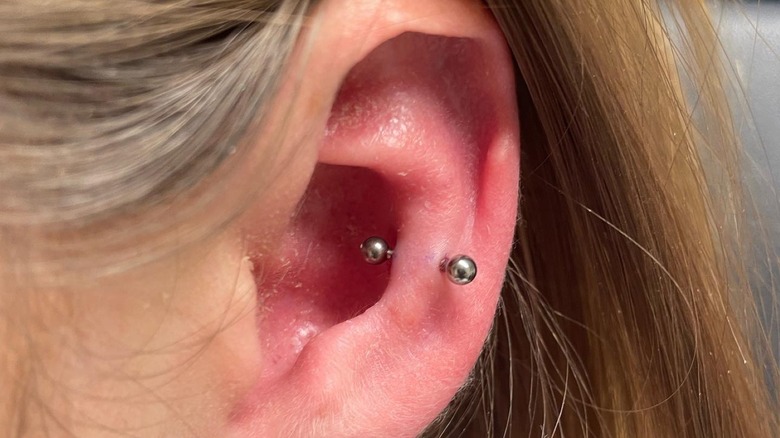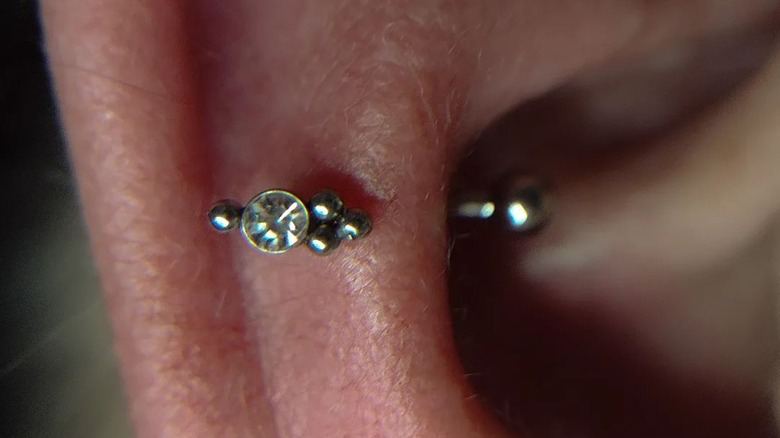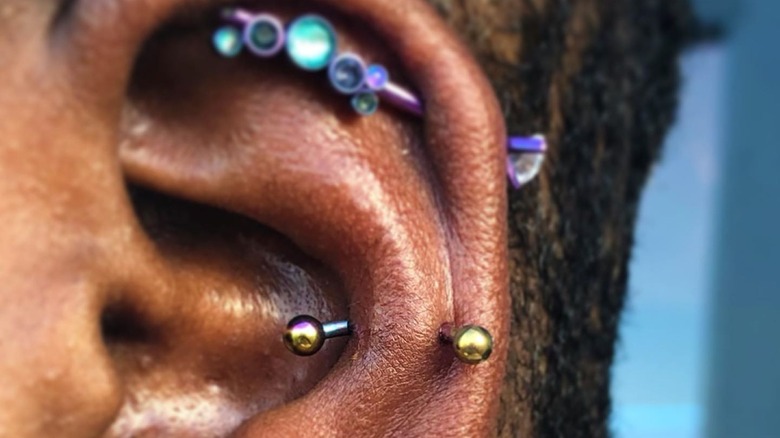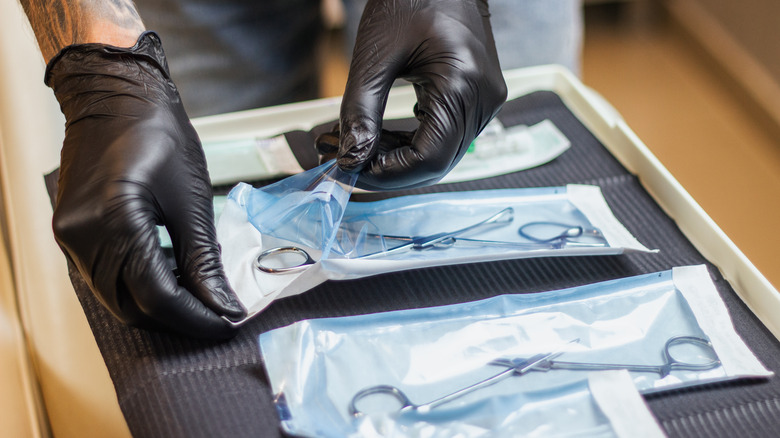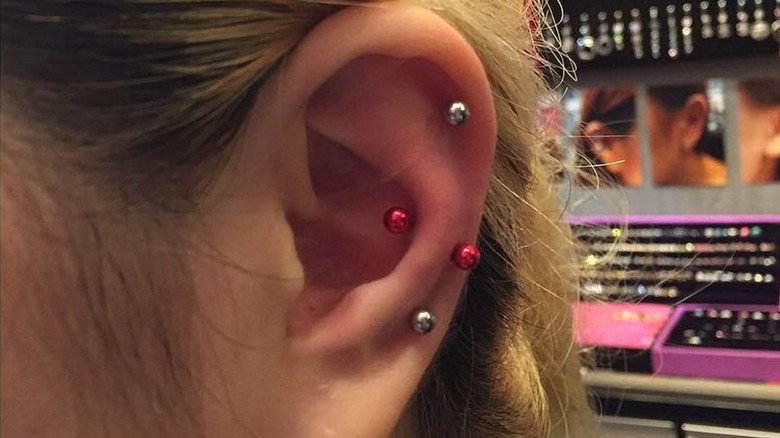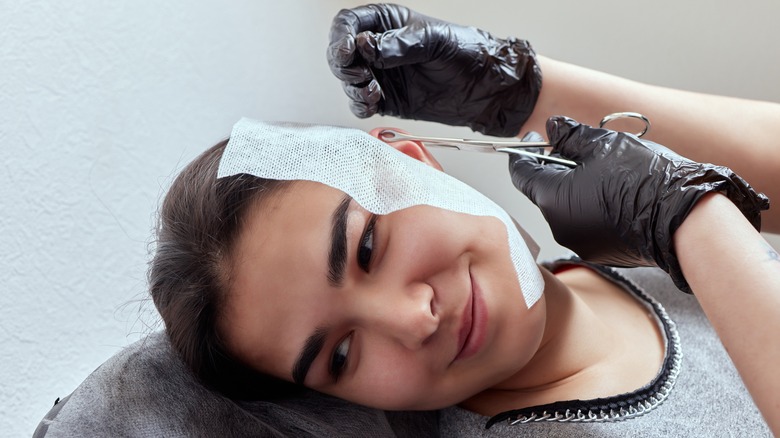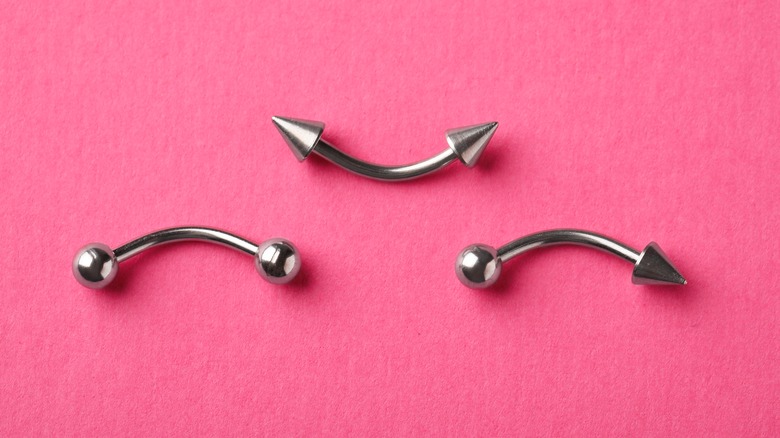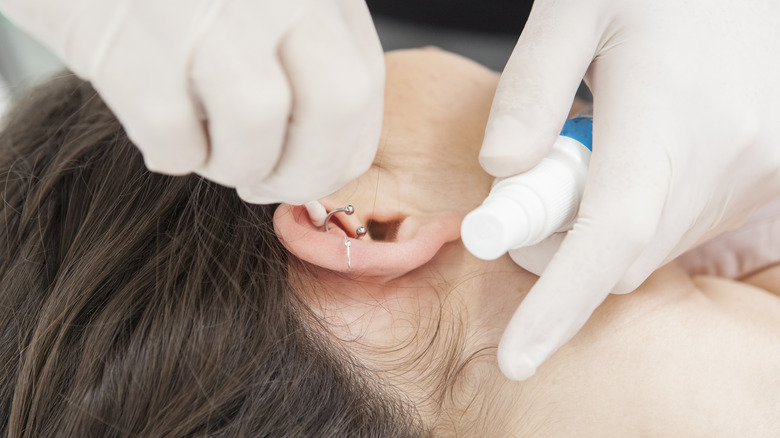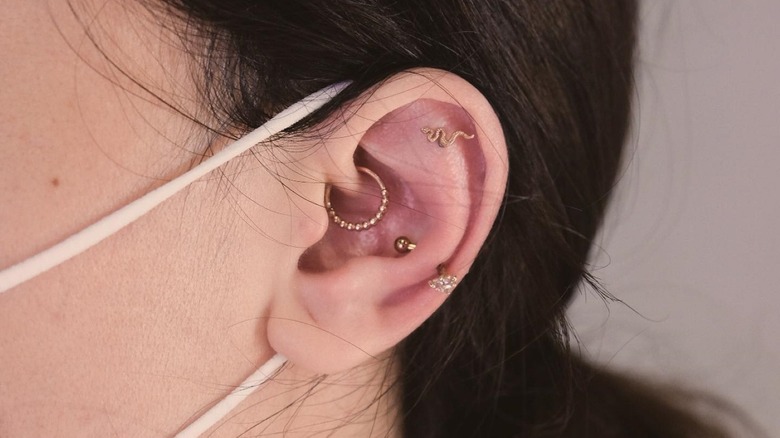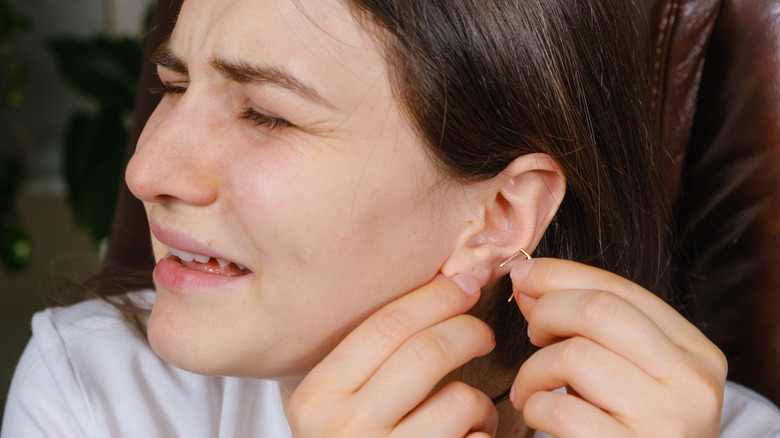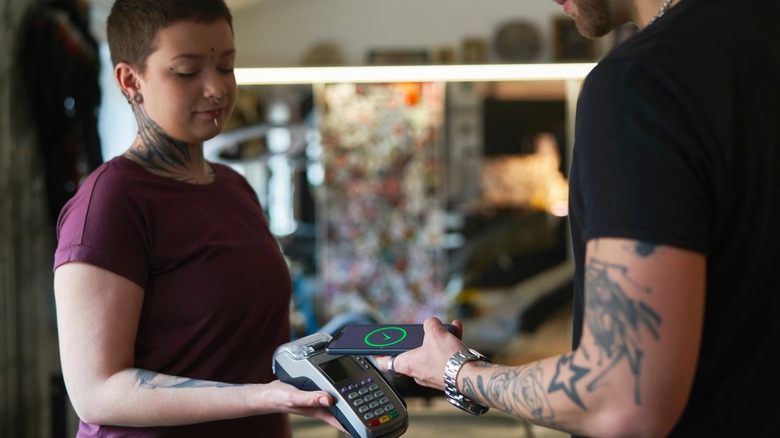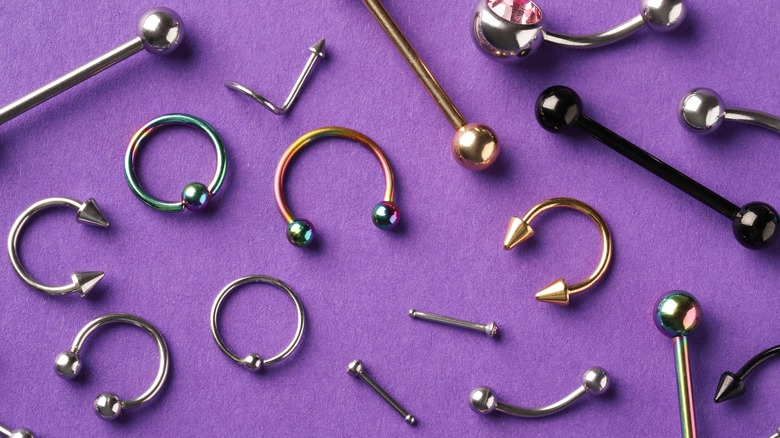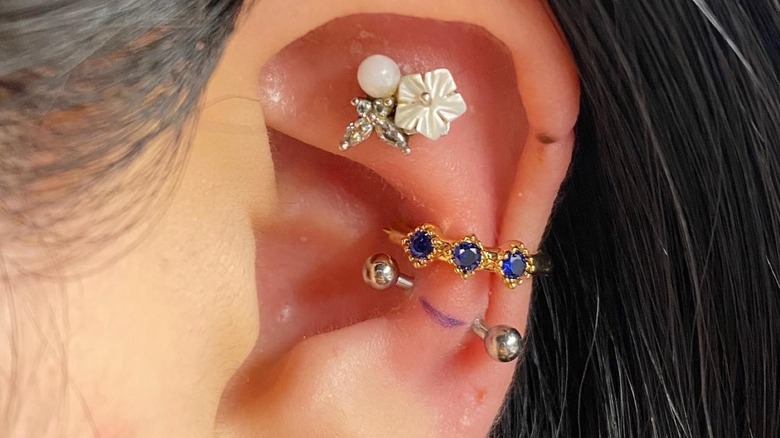Everything You Need To Know Before Getting A Snug Piercing
So, you're thinking about getting a snug piercing. You're considering the piercing as a form of body art to express your individuality and personal style. Whether you're new to the world of cartilage piercing or a seasoned vet, the snug is undoubtedly one of the coolest and most unique-looking ear piercings you can get.
The snug is not as common as other cartilage piercings, like the helix, daith, tragus, or rook, but given its central location, it can be a great addition to one's curated look, as well as a beautiful complement to these and other ear piercings. Or, it can work perfectly as a stand-alone piercing, the lone star of the show. Not sure if you want to take the leap? Glam has the answers to all your burning questions as well as some you may not have even thought of yet. Now, let's uncover everything you need to know before getting a snug piercing.
What is a snug piercing?
A snug piercing is one that goes through the antihelix, which is the curved piece of cartilage between the helix (or outer rim) and concha (or inner "cup") of the ear. Thanks to the 1991 discovery of the mummified body known as Ötzi the Iceman in an iceberg in Italy, we know that ear piercing dates back over 5,000 years, all the way to the fourth millennium.
The practice has spanned across centuries and cultures, with tribes and groups of people from Persia, Rome, Turkey, England, South America, Borneo, Polynesia, Egypt, and various other parts of Africa all having adorned their ears in many different ways — and for many different reasons — throughout history (via Painful Pleasures). Piercing the antihelix, however, is a relatively new trend. Dr. Piercing Aftercare explains that the snug piercing trend really began in the 1980s before becoming somewhat of a fad. However, it's unknown who it began with or where it started.
How did the snug piercing get its name?
With a name that evokes imagery of warm cuddles or being tucked into a soft, comfy bed, you're probably wondering why the snug piercing is called such. Unlike most other cartilage piercings, the snug is not named for the part of the ear the piercing is done in. (Nope, there is no part of the ear called the snug.) You may be surprised to find out that its name has nothing to do with the way the antihelix seems to be cozily nestled between the balls at each end of the barbell after piercing.
According to Body Candy, the snug piercing was given its moniker in the 1990s by Caitlin Theobald, who named the piercing after the clothing line Snug Industries. Now, it has grown increasingly popular in recent years and is expected to continue to trend and become more and more in demand among the piercing community and body art lovers.
What is the process of having a snug piercing done?
Prior to getting your piercing done, you should do your research to find an experienced, reputable, and professional piercer. Upon arriving at the piercing shop, WebMD recommends looking for some type of official certification or license, which should be hanging on the wall. If you arrive and the environment does not appear clean and hygienic — or if your piercer attempts to do the piercing without wearing gloves — these are red flags indicating it may be best to try another place.
Any piercing process will begin with the cleaning of the area to be pierced. Some piercers will mark the location on your ear to designate the exact piercing point. Next, the piercing professional will perform the piercing using a sterilized hollow point needle. Furthermore, a piercing gun should never be used for a snug (or any other type of cartilage) piercing, as it can cause serious problems as a result of blunt force trauma, which should never happen when getting something as fun as a piercing. Once pierced, the piercer will insert the jewelry and provide you with aftercare instructions. The whole process should only take a few minutes in total.
Not everyone can get a snug piercing
It's possible that you will show up to get a snug piercing only to be informed that your ear anatomy is simply not right for one. This type of piercing can only be done on people with a particular shape of ear that includes a prominent antihelix.
According to Dr. Piercing Aftercare, this is specifically because it highlights such a distinctive feature of the ear, something that traditional ear piercings don't have to worry about. Therefore, this piercing is perfect for anyone with a "protruding ridge," as it traverses toward the inner ear from the antihelix. Still, don't worry; many people who think they can't have this piercing are able to have it done. In the event that your piercer tells you that you are one of those whose structure will not support a snug piercing, there are other options to choose from, including a faux snug piercing.
According to pro piercer Sara of Brilliance Bay, "'Faux Snug Piercing' is [a] great alternative to the conventional Snug. It is basically two separate piercings: a conch piercing positioned parallel with an outer helix piercing, to give the illusion of a regular Snug. Both piercings can also be styled differently to give this piercing a lot more versatility with jewelry than a conventional Snug (which can only wear a curved barbell)." Who doesn't love a workaround?
How painful are snug piercings?
Though pain tolerance varies from person to person, snug piercings are generally considered to be one of the most painful piercings you can get. The parts of the ear containing cartilage are harder and denser than those without it, and the cartilage of the antihelix is thicker than the cartilage in most other parts of the ear. Puncturing the antihelix requires more force, so you will feel more pressure and pain.
While some people consider the piercing itself to be the most painful part, others say it hurt more for them when the jewelry was inserted. Again, this will differ between people. Urban Body Jewelry recommends that you focus on your breathing, which will help you stay calm, and try to stay as still as possible. The outlet also notes that you can trust an experienced piercer to be supportive and push the needle through quickly and safely.
What type of jewelry is initially used for snug piercings?
According to Urban Body Jewelry, curved barbells are the most suitable type of jewelry for when you first get your snug piercing, and your piercer will most likely use a 16 gauge, 3/8-inch earring. Using a longer barbell allows ample room for the inevitable swelling that will occur. Once your piercing is fully healed, you can swap the initial barbell for a different type of jewelry, which we will discuss more in depth later.
There are a variety of materials you can choose from for your jewelry. Many people have allergic reactions to nickel, so if you're unsure whether or not you are allergic to this metal, you should avoid any jewelry containing it. Nickel can be found in gold, silver, and titanium jewelry; however, all of these metals can also be made without it, so always inquire before purchasing. Nickel-free and easy to sterilize, surgical stainless steel is the best option for your initial piercing.
Caring for a new snug piercing
You'll want to be sure to clean your new snug piercing twice a day using only a mild, sudsy soap, saline solution, or other topical solution your piercer might provide. Wash your hands thoroughly before cleaning it, and do not use alcohol, peroxide, witch hazel, antibiotic ointments, or any other type of harsh chemical on your piercing. Be careful not to rotate, snag, or bump the jewelry. All of these things can irritate your piercing and interfere with the healing process.
H2Ocean also says it's important not to lay on the ear your new piercing is in and to keep your hair, cell phone, and headphones off of it, as these are also ways you can potentially irritate or introduce bacteria into the piercing site. Instead, use your other ear or speakerphone. While your piercing is healing, avoid public swimming pools and water parks where you may expose it to unclean water full of germs, bacteria, and chemicals.
Healing times for snug piercings
You can expect your new snug piercing to take at least four to six months to heal. However, since the piercing is located in a thicker piece of cartilage, it will take longer than it would in thinner areas. In fact, it is not unheard of for snug piercings to take up to a full year to completely heal.
During this time, it is important to continue washing your piercing regularly in the manner instructed by your piercer. Aftercare plays a major role in the healing process, so be sure not to neglect it. Stay vigilant in protecting your piercing and keeping it clean. Failing to follow any of the aftercare instructions can cause your piercing to heal more slowly. Developing any kind of adverse side effect or complication, which can, unfortunately, happen no matter how vigilant you are when cleaning, could also disrupt the healing process and make it take longer.
Possible side effects after getting a snug piercing
Before getting your snug piercing done, familiarize yourself with the potential side effects and symptoms that could indicate a problem. Even expertly pierced ears will ooze blood and other, usually clear, fluids at times, so don't take these signs as immediate red flags. These should improve over time.
With any piercing, there are potential side effects. Possible problems to be aware of are contact dermatitis, keloids, migration, and rejection. Contact dermatitis occurs when the skin has an allergic reaction. It is often a red, itchy rash that can also appear flaky, blistery, scaly, or oozy (via the Mayo Clinic). Keloids, meanwhile, are a type of raised scar that can form after a skin injury. They are more common in people with darker skin and those with a family history of keloids. There is no non-invasive way to treat them, as WebMD notes that surgery is the only option for removing them. Then, migration refers to a piercing moving from its original location, while rejection occurs as a result of the body wanting to rid itself of a foreign object.
According to Medical News Today, signs of piercing rejection include the jewelry sitting differently in your skin, the ability to see more of the jewelry than usual on either side of your skin, continued bleeding and/or soreness, and the piercing hole getting bigger over time, among others. Monitor your piercing closely and call your healthcare provider with any questions or concerns.
Signs of infection and what to do if your snug piercing gets infected
In addition to the aforementioned issues, it is possible that your new snug piercing can become infected. It is important to follow your aftercare instructions and properly clean and care for your piercing to minimize your risk of infection. However, sometimes, despite one's best efforts to protect and keep a new snug piercing clean, it can still become infected. In fact, WebMD cautions that more cartilage piercings, an estimated 30%, get infected than traditional earlobe piercings, which is about 20%.
While regular discharge is clear or tinged yellow, infected discharge can veer into black and gray colors, and it often smells. These are all signs that you should get your ear checked out. The same applies if your ear remains red or pink long-term, or if it's hot at any given moment. The emittance of heat means it's fighting something. In severe cases, nausea can ensue. Obviously, this is when you should seek professional help. If not treated early, an infection can have very serious consequences. After all, you don't know better than a piercing artist or a doctor, and hubris can, unfortunately, mean harm in cases like this. If left untreated for long enough, the infection can spread from your ear throughout your body and ultimately prove fatal, which would be a rather dark ending for something that started as an act of self-expression.
Options that your healthcare provider might recommend can include using a saline rinse and a warm compress. Your doctor may also prescribe an oral or topical antibiotic medication for you to use.
Cost of getting a snug piercing
Typically, you can expect a snug piercing to cost between $35 and $70. According to Piercee, the price includes the piercer's fee, the cost of the materials utilized, and a basic piece of starter jewelry. There will likely be an additional charge if you would like to select different jewelry.
Pricing is typically determined by the experience level of the piercing professional, though you naturally want someone who has experience doing snug piercings and who is knowledgeable about them. To find a reputable piercer, you can ask for recommendations from people you know or check out others' reviews online. Try visiting different shops beforehand and asking questions to find one that feels right for you.
You should also plan on tipping your piercer afterward. As with food service tipping, a range between 15% and 20% of the total price is a good starting point; however, you may want to tip more if your piercer was exceptional or went above and beyond to help you calm your nerves or solve a problem. Tips make all the difference!
Changing a snug piercing
Once your snug piercing has fully healed and your piercer gives you the green light, you can swap your original jewelry out for a different type if desired. Circular rings, horseshoe rings, and captive bead rings/ball closure rings are all options that can be used (via Body Candy). As with your initial jewelry, be mindful of the material your new piece is made of and avoid using metals that you know or suspect you may be allergic to. Surgical stainless steel remains a great choice.
Body piercing jewelry is also widely available in other materials, such as acrylic and plastic; however, these may not be safe for long-term use. Some types of acrylic contain carcinogens, and there is no evidence of testing that proves the safety of plastics, even for brands like Bioplast and Bioflex, which specialize in plastic jewelry for a wide range of body piercings (via Amato Fine Jewelry & Body Piercing).
How are snug piercings different from auricle and outer conch piercings?
It is possible for people to confuse snug piercings with piercings done on nearby parts of the ear. The auricle piercing is commonly done on the middle of the helix, or outer rim, of the ear. However, it is also done in the fold between the helix and the antihelix. Though the snug piercing "sits in a similar location to the auricle ear piercing, the entrance and exit points of the snug piercing both appear at the front of the ear, so it'll be more aesthetically similar to a rook piercing," explains FreshTrends.
An outer conch piercing is done on the outer edge of the ear's concha. The concha is named as such because it resembles a conch shell, and it can be seen by the ear canal's opening toward the middle of your ear. An outer conch piercing can accommodate a variety of types of jewelry, including studs, barbells, and hoops; however, in the case of the latter two types, part of the jewelry is obscured behind the ear. Given their close proximity to the antihelix, it is easy to see how people may confuse auricle and outer conch piercings with the snug.
